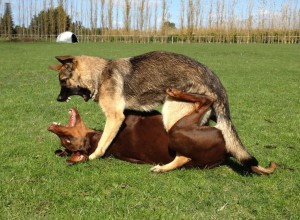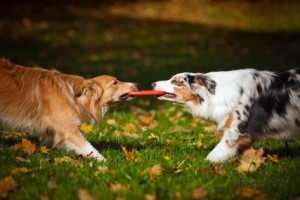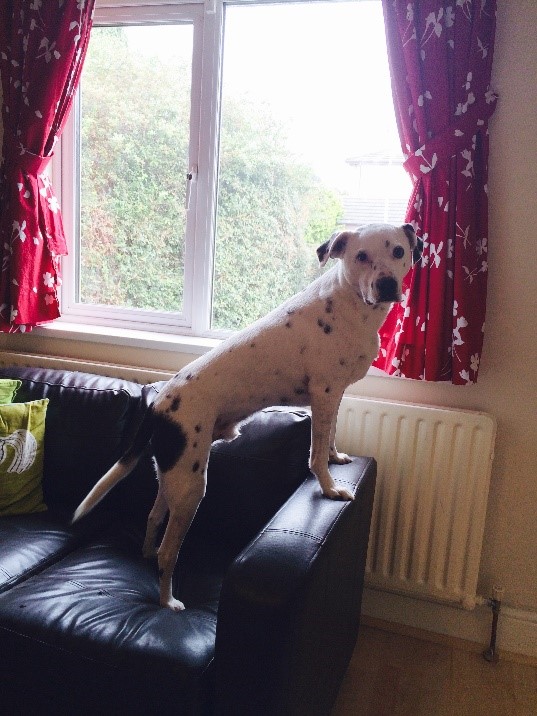I am often asked about interactions between dogs in terms of what is appropriate and polite and equally what is rude or likely to spill over into a row.
 It can be hard for everyone to recognise when two dogs meet in the park for the first time or equally when you have multiple dogs in a home when they are just goofing around or when someone is uncomfortable. Equally due to perhaps insufficient socialisation as a puppy or poor experiences as an adult we have increasingly more and more dogs that struggle with on lead greeting and knowing “what to say” when meeting other dogs in various situations.
It can be hard for everyone to recognise when two dogs meet in the park for the first time or equally when you have multiple dogs in a home when they are just goofing around or when someone is uncomfortable. Equally due to perhaps insufficient socialisation as a puppy or poor experiences as an adult we have increasingly more and more dogs that struggle with on lead greeting and knowing “what to say” when meeting other dogs in various situations.
Believe it or not both picture depict dogs playing! 
As the person at the other end of the lead or sitting on the sofa in the living room, it can be tricky to determine if and when you should get involved. The most important element is to try learn your dogs’ body language so that you can look out for the signs that they are happy, tense, excited, anxious etc. This will allow you to read the situation and if necessary help them out by calming down the play, moving them along if out on a walk or equally if all parties are having heaps of fun, leaving them to enjoy themselves.
So how do you learn to read your dog?
This is where is can get a little tricky and it is very much a case of observing your dog and tuning in to their own specific various ways of physically expressing themselves.
There are lots of different signs that can be seen across most dogs that show when they are happy, tense, unsure etc. However, they do vary from breed to breed – for example a Pug showing lots of the white of their eye could simply be related to the shape of their face, whereas a Labrador doing it may be connected to them feeling anxious.


There are two great body language books available if you are like me (aka a bookworm!) and would like to learn more about reading body language.
- Canine Body Language – a Photographic Guide by Brenda Aloff
- Canine Behaviour – a Photo Illustrated Handbook by Barbara Handelman
So we have established the best way to know how your dog is feeling is to start watching their body language and to try and tune in to how they are feeling as this will give you an indicator on how they are likely to behave. We also want to make sure that we avoid placing our dogs in situations where they are likely to fail. For example if you know your dog only likes to play at 500 miles an hour perhaps don’t introduce him to your friends 15 year old creaky plodder off lead in the park as they are unlikely to hit it off! If you want them to be friends fantastic, but perhaps it would be an idea to take your dog out for a walk and let them burn off some steam and then on the way home meet up for an on lead stroll back to the house.
So you have two dogs and you wonder if their play in appropriate or unbalanced i.e. one is getting picked on or the play is so OTT it spills over into a tiff.
If you ever feel play is likely to escalate to a point where it might result in a row – defuse the situation by asking your dogs to do something else.
Much like when we have over exuberant kids and we warn “this will all end in tears!” we need to help them to come back down to a more manageable level.
In homes that have multiple high energy dogs I personally feel it is fair to have the house as a no play zone and all high energy play is restricted to when the dogs are in the garden together. Otherwise you can end up in a situation where you have dogs tearing around, barking and bouncing off furniture when you are trying to prepare dinner, get children ready for bed etc.
So if they are giddy and start barking and goofing around wanting to play just open the door and encourage them to head outside.
Note: It is important that encouraging the dogs to head outside and play only happens with dogs that are pretty relaxed in the garden and enjoy spending time out there as otherwise it could potentially feel like they are being punished for playing. If your dogs are not happy to go outside and play or if it is at a time where it is not suitable e.g. 6am in the morning, pop them on either side of a baby gate with something fun to do separately like munching on a bone.
Equally while you want your dogs to learn that outside is for tearing around and being silly with one another, inside is the space they practice calm, settled behaviour. Therefore this is where you need to teach and practice their basic cues – sit, down, bed etc. give them chill out chew time and quiet fuss off the family.
Remember it is important to praise both dogs when they are chilled out as often we only give our dogs attention when they are doing something we don’t want such as jumping up, barking etc. and forget to tell them “good job” when they are relaxed in their beds.
Video Examples of positive and not so positive dog to dog interactions
Balanced play
Believe it or not it is really tricky to find a nice video of balanced play on the internet! This is a good video but it would be even better if it showed the Pitbull (Blue & White) lying down.
Ideally when we look at play between two dogs we look for it to be reciprocated – i.e. they take turns being chased, being on top, winning the toy etc. You can see how these dogs are mirroring one another’s behaviour – what one does is then offered by the other dog in return. J
Unbalanced play
The black Pitbull mix “Inky” is holding the other dog down and not allowing for any reciprocated play. The owner mentions in the write up below the video that Inky is the “dominant” one but in fact the truth is Inky doesn’t have sufficiently good doggy skills to play appropriately. If the other Pitbull Twilight didn’t have such good dogs skills (& such a tolerance for Inky’s rudeness) it would likely spill over into a row. This type of play shouldn’t be allowed to continue as Twilight is definitely being picked on. Her owner does at one point tell Inky to let her up but then allows her to go back to pinning Twilight when the best course of action would be to call the dogs away and get them to do something else.
Polite greeting off lead
You can see the larger dog is a little tense to begin with as everything about his body looks a little too alert but then he flicks his ears back and his body softens as the smaller Collie has a good sniff. When she comes up to his face (where there could potentially be an issue) he instigated play by throwing a half play bow and running away to be chased. J
Inappropriate dog greeting off lead
The smaller female Scotty dog in the video is worried by the large male American Bulldog and tries to communicate this by moving away at every opportunity or position herself under furniture of beside the people in the room (hoping they will offer some support – which they sadly don’t and allow the larger dog to continue to bother her). She has to communicate her anxiety but showing teeth, air snapping and barking at the other dog repeatedly before he listens and leaves her alone. Really the owners should interview before this point and give the little lady an escape option so she doesn’t feel she needs to resort to these behaviour as not only is it distressing for her, it is not pleasant for the Bulldog.
Any questions pop them in the comments section below.
Happy training everyone 


